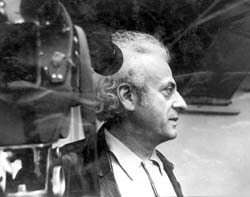A diadelphous study of one of Ukraine’ s oldest cinematographers is completed

Despite the obvious deep recession of the domestic filmmaking industry, the Kyivnaukfilm Studios has produced a new documentary. Actually, two: Passengers from the Past Century and At a Strange Railroad Station. They form a duo of works about the life and destiny of Israel Goldstein, one of the Ukraine’s most senior cinematographers. Simultaneously, the authors correctly point out that their production is “about the details and fragments of the times that are on film not only thanks to our hero, but also as the result of the selfless efforts of several generations of twentieth century filmmakers.” The film was directed by Viktor Olender and the director of photography was Anatoly Solopai.
The premiere took place at the capital’s House of Cinematographers. In addition to the film crew led by the director, the packed audience could watch and listen to the hero who, despite his age, was in attendance, noticeably excited. “I thought you wouldn’t come, but you did...” he said. “Reviving the documentary cinema in Ukraine is an historic event. Congratulations!”
Mykhailo Bielikov called Goldstein “a living history of the Ukrainian cinema.” As for the documentary, its story runs as follows. Several years ago there appeared the initiative of making a documentary series titled While A mong the Living, but the project failed. Then they decided to make a documentary about one of the heroes and chose Goldstein. In the words of director Olender, the result was a film of nostalgia, meaning a longing not for the past but for the present. It took two and a half years.
Passengers from the Past starts with the hero’s birth and ends with victory in World War II. There was Kyiv in 1918, Duma Square, currently Independence Square, and Goldstein was born there. Rare documentary scenes accompanied by Israel Goldstein’s running commentary off screen. Remarkably penetrating descriptions, eloquent details from the narrator’s memory, a subtle touch of paradox laying bare the essence of things, and a keen sense of humor born of refined intellect... “When I was born there was a monument to Stolypin on the square and then to Marx; one to Lenin was erected later, but would not stand long. And so I conclude that the place is bad for monuments.” What else did they build opposite the greenhouse, beside the winged legionnaire? Then he enrolled in the Kyiv Institute of Cinematography, a branch of the Moscow State Institute of Cinematography, and after graduation was sent to brotherly Armenia to help develop the national filmmaking industry there. The alternative was a year in prison.
Then the war broke out. He was a documentary filmmaker, meaning that he made films about what actually happened. Telegrams kept coming from Moscow: “We need victories, destroyed German materiel...” Where could he get any of that back in 1941? Goldstein was one of those filming the living hell of Stalingrad, scenes that would be shown around the world. An interesting fact is that of fifteen cameramen only three were wounded. None was killed, although 52 documentary filmmakers died during the war. There is much about Oleksandr Dovzhenko in the documentary. Goldstein worked with this brilliant Ukrainian director. The credit lines show some ninety cameramen whose works were used in the production.
At a Strange Railroad Station begins with the first postwar years and ends with somber [Soviet and post-Soviet] realities. A different technique is used, because the epoch is different. A different spirit and style. The emergence of Technicolor is not the point, but what Goldstein describes as a mendacious cinema. “They ordered us to make an increasing number of documentaries about big and small [Party] bosses.” Somehow it makes one think of contemporary Ukrainian television, print, and electronic media. Actually, the documentary is not Goldstein, but Ukraine’s history as seen through Goldstein’s and Olender’s eyes. Sometimes the hero finds himself in funny and at the same time dangerous situations. It happened during a Soviet military parade on Khreshchatyk. That day he received a formal reprimand for breaching safety regulations and a premium of 300 rubles for “courage and resourcefulness.” He had positioned himself and the camera too close to the passing tanks and missiles on trucks, without coordinating his position with the competent authorities. A considerable part of the documentary is dedicated to the appearance of political parties in Ukraine at the dawn of independence, the first miners’ strikes, mendacious political system, democrats succumbing to the temptation of power... Goldstein shows the entire farce of what is still described as political life. The film incorporates the efforts of some 70 cameramen.
There is practically no documentary cinematography in today’s Ukraine, because there are no budget subsidies. Goldstein, however, ends on an optimistic note: “Young people are the only one to assume that the old do not want to live. Nonsense...” And he several times repeats the phrase used as the heading above.






